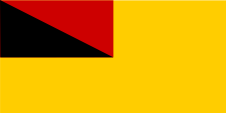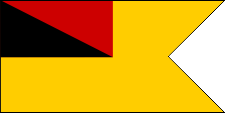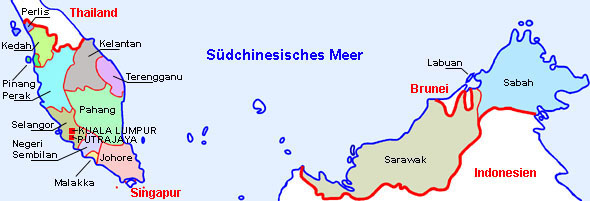Negeri Sembilan |
|
|
|
| Übersicht – Contents: | |
Diese Seite ist Teil des Projektes
Negeri Sembilan |
|
|
|
| Übersicht – Contents: | |
Flagge – Flag: |
|
 |
Nationalflagge – national flag, Seitenverhältnis – ratio = 1:2, Quelle/Source, nach/by: Die Welt im bunten Flaggenbild |
historische Flagge – historical Flag: |
|
 |
1876–1941, Flagge des britischen Residenten – Flag of the British Resident, Quelle/Source, nach/by: Flags of the World |
Bedeutung/Ursprung der Flagge – Meaning/Origin of the Flag: |
|
| Negeri Sembilan verwendete anfänglich eine einfarbige rote Flagge. Offenbar geht dies auf den Einfluss des Sultanats Aceh zurück. Erst 1895 nahm Negeri Sembilan eine einfarbige gelbe Flagge mit einer schwarz-roten Oberecke an. Das Gelb steht für den Yang-di-Per Tuan Besar ("Großer Herrscher"), der sich noch bis 1946 Radscha nannte. Das rote Dreieck symbolisiert das Volk. Das schwarze Dreieck in der Oberecke erinnert an die schwarzen Dreieckswimpel, die von den vier Häuptlingen der "Vier Staaten" verwendet werden. Negeri Sembilan heißt "Neun Staaten". In Wirklichkeit besteht es heute nur nur aus vier Staaten: Sungei Ujong, Jelebu, Johol und Rembau, die jeder von einer Art Häuptling geführt werden. Über allem steht der Sultan. Er hat keine eigene Flagge. |
Negeri Sembilan used initially a single-coloured red flag. That has
obviously its roots in influence of the Sultanate of Aceh. Not until 1895
Negeri Sembilan adoped a single-coloured yellow flag with a black and red
upper staff quadrant. The yellow stands for the Yang-di-Per Tuan Besar
("Great Ruler") which was just named Rajah until 1946. The red triangle
symbolizes the people. The black triangle in the upper staff quadrant
remembers the black triangle pennants which are in use by the four
Chieftains of the "Four States". Negeri Sembilan means "Nine States". In reality it consists today only of four states: Sungei Ujong, Jelebu, Johol and Rembau. Everyone is lead by a kind of Chieftain. Above of all stands the Sultan. He doesn't use an own flag. |
| Quelle/Source: Die Welt im bunten Flaggenbild | |
Wappen – Coat of Arms: |
|
 |
Wappen von Negeri Sembilan – coat of arms of Negeri Sembilan, Quelle/Source, nach by: Wikipedia (EN) |
Bedeutung/Ursprung des Wappens – Meaning/Origin of the Coat of Arms: |
|
| Das Wappen von Negeri Sembilan orientiert sich an westlicher Heraldik. Es ist zweifach schräg rechts geteilt und zeigt die Farben Rot, Schwarz und Gelb, die auch auf der Flagge zu finden sind. Gelb ist die Farbe des Yang Di-Pertuan Besar, Schwarz ist die Farbe der Undangs (Fürsten), Rot erinnert an die Verbindungen zu Großbritannien und steht für das Volk. In der Mitte des Schilds sind neun gelbe Reishalme platziert, die auf einem Spruchband mit dem Landesnamen stehen. Die Reishalme verdeutlichen den Sinn des Landesnamens, denn Negeri Sembilan heißt "Neun Staaten", und erinnern - wie der neunzackige Stern im Schildfuß - an einige der (ehemaligen) neun Teilstaaten Jelai (Inas), Jelebu, Johol, Kelang, Nanaing, Rembau, Segamat und Pasir Besar, Sungei Ujong und Ulu Pahan, deren Anzahl sich über die Jahre allerdings änderte. Oberhalb des Schilds erscheinen ein Stab, ein rotes Schwert und eine rote Scheide. Der Stab ist der Changgai Puteri des Yang Di-Pertuan Besar, neben dem Schwert ein wichtiges Insignium dieses Monarchen. |
The coat of arms of Negeri Sembilan is based on Western heraldry. It is two
times split diagonally to the right and shows the colors red, black and
yellow, which can also be found on the flag. Yellow is the color of the Yang
Di-Pertuan Besar, black is the color of the Undangs (Princes), red reminds
of the connections to United Kingdom and represents the people. In the middle of the shield, there are nine yellow stalks of rice on a banner, which shows the name of the country. The stalks of rice illustrate the meaning of the name, because Negeri Sembilan means "Nine States", and reminds - like the nine-pointed star in the lower part of the shield - to some of the (former) nine states Jelai (Inas), Jelebu, Johol, Kelang, Nanaing, Rembau, Segamat and Pasir Besar, Sungei Ujong and Ulu Pahan; whose numbers changed over the years, however. Above the shield appears a staff, a red sword and a red scabbard. The staff is the Changgai Puteri of the Yang Di-Pertuan Besar, next to the sword an important insignia of this monarch. |
| Quelle/Source: Wikipedia (EN) | |
Landkarte – Map: |
|
| Die Bundesstaaten Malaysias – the Federal States of Malaysia: |
| interaktive Landkarte – interactive Map |
 Landkarte/Map: Volker Preuß nach/to Malaysia? => hier klicken – click here |
Zahlen und Fakten – Numbers and Facts: |
|
|
|
|
|
|
|
|
|
|
|
|
|
|
|
|
|
|
|
|
|
|
Geschichte: |
|
7.–12.Jhd. · zum Reich Shrividjaja 14.–15.Jhd. · zum Reich Madjapahit 15. Jhd. · zum Sultanat Malakka 1511 · Malacca wird von Portugal erobert, die Region des heutigen Negeri Sembilan kommt an das Sultanat Johor 1773 · der Sultan von Johor bestätigt das unabhängige Sultanat ca. 1800–1873 · Bürgerkrieg 1873 · Großbritannien greift in den Bürgerkrieg ein 1876–1895 · Großbritannien vereinigt alle lokalen Teilfürstentümer (die zum Teil bis heute als Distrikte und Fürstentümer fortbestehen) unter dem Namen Negeri Sembilan und unterstellt das Land einem britischen Residenten, das Land wird britisches Protektorat 1895 · Perak, Pahang, Selangor, Negeri Sembilan werden zu den "Föderierten Malaienstaaten" zusammengefasst (Malaiischer Bund, bis 1941) 1941 · japanische Eroberung 1945 · Abzug der Japaner 01.04.1946 · Bildung der Malaiischen Union durch Zusammenschluss der Malaiischen Sultanate (Britische Protektorate) und der Straits Settlements (Britische Kronkolonien), jedoch ohne Singapur 1948 · Reorganisation der Malaiischen Union, Bildung der Malaiischen Föderation unter einem britischen Hochkommissar 31.08.1957 · Unabhängigkeit und Proklamation des Königreiches Malaiische Föderation 16.09.1963 · Proklamation des Königreiches Malaysia durch Zusammenschluss der Malaiischen Föderation (Malaya) mit den ehemaligen britischen Kolonien Sarawak, Sabah (Nordborneo) und Singapur. Brunei lehnte den Beitritt ab und verblieb bei Großbritannien 09.08.1965 · Singapur verlässt die Föderation von Malaysia |
History: |
| 7th–12th
cent. · to the Shrividjaja Empire 14th–15th cent. · to the Madjapahit Empire 15th cent. · to the Sultanate of Malacca 1511 · Malacca is conquered by Portugal, the region of today's Negeri Sembilan comes to the Sultanate of Johor 1773 · the Sultan of Johor confirms the independent sultanate ca. 1800–1873 · civil war 1873 · United Kingdom intervenes in the civil war 1876–1895 · United Kingdom unites all local principalities (which partially remain until today as districts and principalities) under the name of Negeri Sembilan and subordinates the country under a British Resident, the country becomes a British protectorate 1895 · Perak, Pahang, Selangor, Negeri Sembilan become summarized to the "Federated Malay States" (until 1941) 1941 · Japanese conquest 1945 · withdrawal of the Japanese 1st of April 1946 · formation of the Malay Union by confederation of the Malaysian Sultanates (British protectorates) and the Straits Settlements (British crown colonies), but without Singapore 1948 · re-organization of the Malaysian Union, creation of the Malaysian Federation under a British High Commissioner 31st of August 1957 · independence and proclamation of the Kingdom of Malaysian Federation 16th of September 1963 · proclamation of the Kingdom of Malaysia by confederation of the Malaysian Federation (Malaya) with the former British colonies Sarawak, Sabah (North Borneo) and Singapore. Brunei rejects the joining and remains at United Kingdom 9th of August 1965 · Singapore leaves the Federation of Malaysia |
| Quelle/Source: Wikipedia (EN), Atlas zur Geschichte, Discovery '97 |
| Negeri Sembilan heißt "Neun Staaten". In Wirklichkeit besteht es heute nur noch aus vier Staaten: Sungei Ujong, Jelebu, Johol und Rembau. | Negeri
Sembilan means "Nine States". In reality it consists today only of four states: Sungei
Ujong, Jelebu, Johol and Rembau. |
| Quelle/Source: Die Welt im bunten Flaggenbild | |